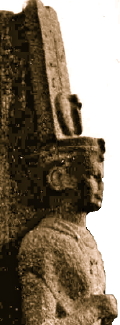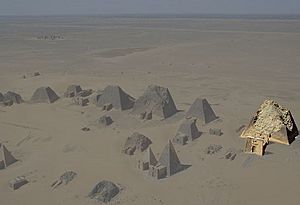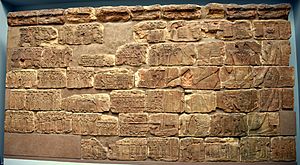Shanakdakhete facts for kids
Quick facts for kids Shanakdakheto |
|||||
|---|---|---|---|---|---|
| Kandake of Kush | |||||

Shanakdakheto statue (Cairo Museum)
|
|||||
| Reign | (ca. 170–160 BCE) or (ca. 170–150 BCE) | ||||
| Predecessor | Unknown Qore | ||||
| Successor | Tanyidamani | ||||
| Burial | ca. 160 BCE Pyramid at Meroë (Beg. N11) |
||||
|
|||||
| Dynasty | Meroitic | ||||
Shanakdakheto was a powerful queen who ruled the ancient Kingdom of Kush. This kingdom was located in Nubia, a region in what is now modern-day Sudan. Shanakdakheto's capital city was Meroë. She is known as the earliest African queen who ruled with full power in ancient Nubia. Her reign lasted from about 170 BC to 150 BC, or possibly 170 BC to 160 BC. She was a very important figure in the Meroitic religion and ruled without a king by her side. Around the 2nd century BC, Queen Shanakdakheto built a special temple called Temple F in a place called Naqa. This temple has unique inside walls where the statues of gods face the back wall.
Discovering Queen Shanakdakheto

Queen Shanakdakheto's name is carved in ancient Egyptian writing, called hieroglyphs, in Temple F at Naqa. These carvings show her royal title: "Son of Re, Lord of the Two Lands, Shanakdakheto." This title meant she was as powerful as a king.
The people of Meroë started writing their own language, called Meroitic, in the early 2nd century BC. Even today, we haven't fully figured out what all the Meroitic words mean. Some of the very first writings in this language are from Queen Shanakdakheto's time in Temple F at Naqa.
Queen's Royal Appearance
We don't know much about Queen Shanakdakheto's family. However, carvings show her wearing a special crown with a sun-disk and tall feathers, just like kings wore. She also had a royal costume, similar to those seen in ancient Egyptian art. Her necklace and earrings had goat heads, which were sacred to the god Amun in Nubian traditions.
In some carvings, a young prince stands next to her. He wears a simple band as a crown. Both the queen and the prince are shown stepping forward with their left foot. The queen is shown as strong and beautiful, covered in jewelry. This showed her wealth, power, and the prosperity of her kingdom.
Art and Burial Customs
The art in Queen Shanakdakheto's burial chapel is very detailed and beautiful. One carving shows her sitting on a royal seat shaped like a lion. She holds a spear and a palm branch in her right hand, with her left hand raised. She is wearing fancy clothes and lots of jewelry.
A special carving found in Naqa is one of the earliest writings in the Meroitic language. Queen Shanakdakheto's pyramid was found at Meroë, near another ruler named Tanyidamani. However, her name isn't clearly preserved on her pyramid. In the carvings inside her tomb chapel, men are shown holding arrows. This was a common burial custom in Meroë.
A stone carving at the British Museum shows Queen Shanakdakheto sitting on her throne. A prince stands next to her, and the goddess Isis protects them with her wings. Other carvings show religious offerings, the queen being judged by the god Osiris, and people bringing gifts.


